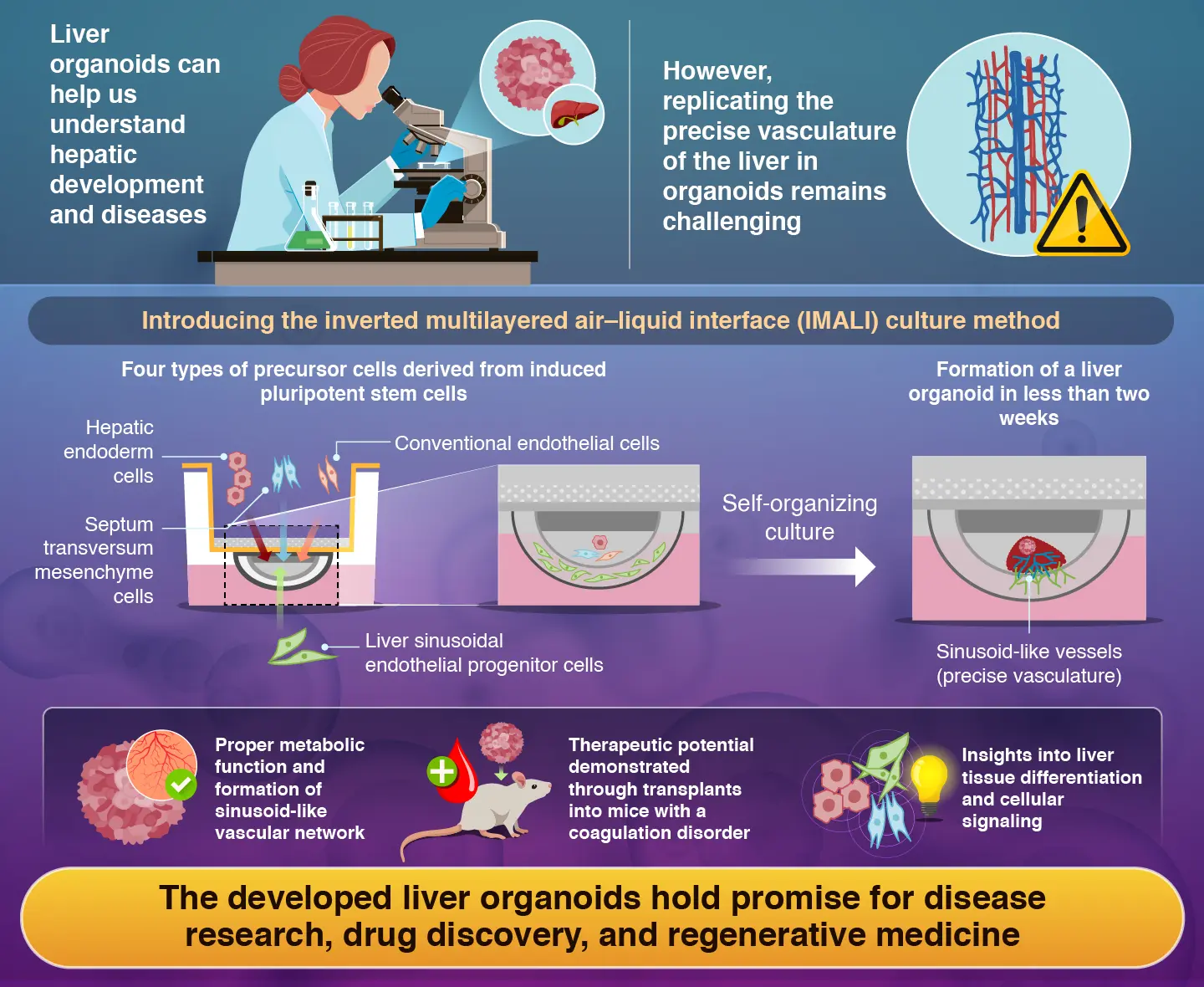Liver organoids with proper blood vessel networks have been successfully produced, as reported by researchers from Institute of Science Tokyo and Cincinnati Children's Hospital Medical Center. This advancement addresses a major challenge in replicating the liver's complex vasculature in lab-grown tissues. Using a novel 3D culture system, the researchers achieved the self-organization of four distinct precursor cell types into functional organoids, capable of producing essential clotting factors in a haemophilia A mouse model.
Recreating Hepatic Sinusoidal Vasculature in 3D Organoids

Saiki et al. (2025) | Nature Biomedical Engineering |10.1038/s41551-025-01416-6
Over the past decade, organoids have become a major focus in biomedical research. These simplified, lab-grown organs can mimic important aspects of human biology, serving as an accessible and powerful tool to study diseases and test drugs. However, replicating the intricate arrangements and networks of blood vessels found in real organs remains a major hurdle. This is especially true for the liver, whose metabolic and detoxification functions rely on its highly specialized vasculature.
Because of such limitations, scientists haven't fully tapped into the potential of liver organoids for studying and treating liver diseases. For example, in hemophilia A, a condition where the body cannot produce enough of a critical clotting factor, current treatments often involve expensive and frequent injections. An ideal long-term solution would restore the body's ability to produce its own clotting factors, which could, in theory, be achieved using liver organoids with fully functional blood vessel structures called sinusoids.
In a recent study, a research team led by Professor Takanori Takebe from the Institute of Integrated Research at Institute of Science Tokyo (Science Tokyo), Japan, and Cincinnati Children's Hospital Medical Center, USA, has successfully created the world's first liver organoids containing authentic sinusoidal-like blood vessels. Their study, published online in the journal Nature Biomedical Engineering on June 25, 2025, describes a novel culture method that enables four different types of progenitor cells to self-organize into functional liver organoids.
First, the researchers established a technique to reliably produce liver sinusoidal endothelial progenitors (LSEPs) from human-induced pluripotent stem cells, something that had been proven difficult in previous studies. They achieved this through a careful cultivation protocol and a timely analysis of key transcriptional changes that occur as stem cells differentiate into endothelial cells.
After this, the researchers developed an innovative 3D culture method called inverted multilayered air–liquid interface (IMALI), which involves arranging multiple cell types in a specialized gel environment. When cultured using the IMALI method, hepatic endoderm cells, mesenchymal cells, arterial endothelial cells, and LSEPs self-organize into dome-shaped liver organoids approximately 3 mm in diameter.
Through detailed genetic analysis, the team discovered that these organoids developed four distinct types of blood vessel cells, with sinusoidal vessel cells becoming dominant over time. "This technique provides a foundational method for embedding organ-specific vascular structures into organoids, contributing to the understanding of human biology and disease," explains Takebe.
Most importantly, the organoids could accurately replicate some key liver metabolic functions, including the stable production of clotting factors. When transplanted into a hemophilia A mice model, the organoids significantly improved bleeding symptoms for up to 5 months. Favorable results were also obtained in tests with human plasma samples from people with coagulation deficiencies.
These findings underscore the true potential of properly vascularized organoids, as Takebe remarks, "Our enhanced organoids may support the development of regenerative therapies for coagulation disorders and end-stage liver failure, as well as drug discovery and disease modeling." This technology could lead to advances in personalized medicine, where organoids grown from a patient's own cells could be used to provide tailored treatments or serve as testing platforms for assessing drug responses.
The research team plans to further explore the applications of these liver organoids and evaluate their long-term stability and safety for clinical use. Further efforts could even extend insights derived from this study to other types of organoids.
Reference
- Authors:
- Norikazu Saiki1,2, Yasunori Nio2,3, Yosuke Yoneyama1, Shuntaro Kawamura1, Kentaro Iwasawa4, Eri Kawakami2,3, Kohei Araki2,3, Junko Fukumura2,3, Tsuyoshi Sakairi2,3, Tamaki Kono2,3, Rio Ohmura1,2, Masaru Koido2, Masaaki Funata2,3, Wendy L. Thompson4, Pamela Cruz-Encarnacion5, Ya-Wen Chen5,6,7,8,9, and Takanori Takebe1,2,4,10,11,12,13*
- Title:
- Self-organization of sinusoidal vessels in pluripotent stem cell-derived human liver bud organoids
- Journal:
- Nature Biomedical Engineering
- Affiliations:
-
1Human Biology Research Unit, Institute of Integrated Research, Institute of Science Tokyo, Japan
2Organoid Medicine Project, T-CiRA Joint Program, Japan
3T-CiRA Discovery, Takeda Pharmaceutical Company Ltd, Japan
4Division of Gastroenterology, Hepatology and Nutrition and Division of Developmental Biology, Cincinnati Children's Hospital Medical Center, USA
5Department of Otolaryngology, Icahn School of Medicine at Mount Sinai, USA
6Department of Cell, Developmental and Regenerative Biology, Icahn School of Medicine at Mount Sinai, USA
7Institute for Regenerative Medicine, Icahn School of Medicine at Mount Sinai, USA
8Institute for Airway Sciences, Icahn School of Medicine at Mount Sinai, USA
9Center for Epithelial and Airway Biology and Regeneration, Icahn School of Medicine at Mount Sinai, USA
10The Center for Stem Cell and Organoid Medicine (CuSTOM), Cincinnati Children's Hospital Medical Center, USA
11Department of Pediatrics, University of Cincinnati College of Medicine, USA
12Communication Design Center, Advanced Medical Research Center, Yokohama City University, Japan
13Department of Genome Biology, Graduate School of Medicine, and Premium Research Institute for Human Metaverse Medicine (WPI-PRIMe), The University of Osaka, Japan






